The month of April is "Crisis Negotiation Month" at ADRhub.com. It is a collaboration between the ACR Crisis Negotiation Section and ADRhub.com and it will bring you articles, tips, info graphics, and a webinar throughout the month.
Enjoy below the second week's articles (see Week One here):

Get your own copy of the above skills sheet that was designed based on research of the effective skills of law enforcement crisis and hostage negotiators.

Saving Lives: The SAFE Model For Resolving Hostage & Crisis Incidents
 (From the book review)- This book is a concise modern-style textbook that allows the reader to get substantive content grounded in research and brought to life by actual examples. The stories are provided in a much more practical and beneficial manner- ones that are straight to the point while also being analytical and utilizing a new model. The end result for the non-hostage negotiator reader is coming away with a firm understanding of what makes negotiators effective in a specific setting, and if he or she chooses, ample opportunities to apply it to their work.
(From the book review)- This book is a concise modern-style textbook that allows the reader to get substantive content grounded in research and brought to life by actual examples. The stories are provided in a much more practical and beneficial manner- ones that are straight to the point while also being analytical and utilizing a new model. The end result for the non-hostage negotiator reader is coming away with a firm understanding of what makes negotiators effective in a specific setting, and if he or she chooses, ample opportunities to apply it to their work.
Behavioral Change Stairway Model
Learn about the hostage and crisis communication strategy created by former FBI chief negotiator Gary Noesner. It is currently used to train FBI agents and other law enforcement negotiators across the country
 “What is destroyed most in high tension situations is trust, and without trust, things will break down very quickly. When they do, they are replaced by increased anxiety and confusion, destroying the participants’ ability to make good, long-term decisions. It is the negotiator’s presence that keeps the trust intact.” - Michael Tsur, International High-Risk Negotiator
“What is destroyed most in high tension situations is trust, and without trust, things will break down very quickly. When they do, they are replaced by increased anxiety and confusion, destroying the participants’ ability to make good, long-term decisions. It is the negotiator’s presence that keeps the trust intact.” - Michael Tsur, International High-Risk Negotiator
The SAFE Model: A Incident in Bowling Green, Kentucky
(excerpt) The model can be employed to resolve critical situations involving terrorist activities, international, "ethnic conflict" incidents, prison uprisings, cult confrontations, disgruntled, potentially violent employees, suicidal individuals, domestic (e.g., spousal violence) situations, barricaded individuals, and emotionally/mentally disturbed individuals…

The SAFE Model of Negotiating Critical Incidents
From the abstract:
When a crisis incident is resolved tactically, however, there is increased public scrutiny as to whether a tactical assault was necessary to resolve the potentially violent event. With this scrutiny has come increased demands for law enforcement to employ the latest and most effective negotiation approaches for peacefully resolving potentially violent encounters that include prison riots, criminal actions, terrorist acts, suicide attempts, and hostage taking situations (Hammer, 2007). Yet not all efforts at negotiating a crisis situation result in a peaceful surrender of the subject. When negotiation fails, hostages, bystanders, police officers and the subject him/her self are at elevated risk of being injured or killed. In this chapter, I focus on the role of negotiation in resolving critical incidents. Specifically, I present, in summary form, the S.A.F.E. crisis negotiation model that is grounded in quantitative research (Hammer & Rogan, 2004; Rogan & Hammer, 1994, 1995, 1998) and more recent discourse analytic investigation (Hammer, 2007).


